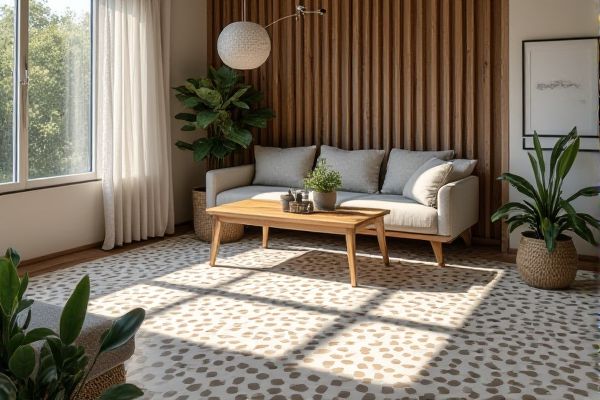
Mosaic tile offers intricate designs and vibrant colors that enhance visual appeal, while stamped concrete provides durable, versatile surfaces with patterns mimicking natural materials. Explore the rest of the article to discover which option best suits your design preferences and functional needs.
Table of Comparison
| Feature | Mosaic Tile | Stamped Concrete |
|---|---|---|
| Material | Small individual tiles made of glass, ceramic, or stone | Concrete surface imprinted with patterns or textures |
| Appearance | Highly decorative, colorful, intricate designs | Simulates natural stone, brick, or wood textures |
| Durability | Resistant to stains and water; can chip if impacted | Extremely durable and weather-resistant; prone to cracking over time |
| Installation | Labor-intensive; requires precise tile placement and grouting | Quicker to install; stamping done on wet concrete before setting |
| Maintenance | Needs periodic grout sealing; tiles easy to clean | Requires sealing every few years to prevent fading and damage |
| Cost | Moderate to high due to labor and materials | Generally lower cost per square foot than mosaic tiles |
| Best Use | Indoor backsplashes, decorative walls, small accent areas | Driveways, patios, walkways, large outdoor surfaces |
Introduction to Mosaic Tile and Stamped Concrete
Mosaic tile consists of small pieces of glass, stone, or ceramic arranged to create intricate patterns and vibrant designs, offering versatility for walls, floors, and decorative surfaces. Stamped concrete is a durable material patterned and textured to replicate natural stone, brick, or wood, providing an affordable alternative for patios, driveways, and walkways. Both materials combine aesthetic appeal with functional durability, catering to diverse architectural and landscaping applications.
Aesthetic Appeal: Design Options and Styles
Mosaic tile offers intricate patterns and vibrant color combinations, allowing for highly customizable designs that enhance your space's visual interest. Stamped concrete mimics natural materials like stone, brick, or wood with textured patterns and earthy tones, providing a durable yet stylish surface. Your choice depends on whether you prefer the detailed artistry of mosaic tile or the versatile, realistic look of stamped concrete.
Durability and Longevity Comparison
Mosaic tile offers exceptional durability with resistance to cracking, fading, and water damage, making it ideal for both indoor and outdoor applications. Stamped concrete, while visually appealing and customizable, tends to be more susceptible to surface wear, cracking, and needs periodic resealing to maintain its longevity. Overall, mosaic tile outperforms stamped concrete in long-term resilience and minimal maintenance requirements.
Installation Process and Time Requirements
Mosaic tile installation involves careful placement of small tiles with adhesive and grout, requiring precise alignment and about 1 to 3 days to complete depending on the area size. Stamped concrete installation requires pouring and leveling fresh concrete, followed by stamping patterns within a limited working time before it sets, typically taking 2 to 5 days including curing time. Your choice impacts project duration, with mosaic tiling demanding more detail work and longer drying periods compared to faster, large-scale stamped concrete applications.
Maintenance and Cleaning Differences
Mosaic tiles require regular sealing to prevent grout discoloration and enhance durability, while stamped concrete benefits from periodic resealing to protect against cracks and surface wear. Cleaning mosaic tiles involves gentle scrubbing with pH-neutral cleaners to avoid damaging the grout, whereas stamped concrete can be maintained with mild detergents and pressure washing to remove dirt and debris. Both surfaces demand prompt stain removal to maintain appearance, but mosaic tiles are more susceptible to grout mold in damp environments, making ventilation important.
Cost Analysis: Upfront and Long-Term Expenses
Mosaic tile installation typically involves higher upfront costs due to intricate labor and material expenses, while stamped concrete offers a more affordable initial price with faster application times. Long-term maintenance for mosaic tiles can be costly, considering potential grout repairs and tile replacements, whereas stamped concrete requires periodic sealing to preserve appearance and durability but generally incurs lower ongoing expenses. Evaluating the total cost of ownership, stamped concrete often presents a more budget-friendly option over time, especially for large surface areas.
Weather and Climate Resistance
Mosaic tile offers superior weather and climate resistance due to its nonporous surface and durable materials such as glass and ceramic, making it ideal for regions with heavy rainfall or temperature fluctuations. Stamped concrete, while visually appealing and customizable, requires regular sealing to prevent cracking and weather damage from freeze-thaw cycles in colder climates. Proper maintenance significantly extends stamped concrete's lifespan, but mosaic tile remains the more resilient option for extreme weather conditions.
Slip Resistance and Safety Considerations
Mosaic tile typically offers enhanced slip resistance due to its textured surface and numerous grout lines, which provide additional grip in wet areas. Stamped concrete can be sealed with anti-slip coatings, but its smoother surface may pose a higher risk of slipping when wet. Safety considerations favor mosaic tile installations in environments prone to moisture, such as bathrooms and pool decks, where minimizing slip hazards is critical.
Eco-Friendliness and Sustainability
Mosaic tile is often more eco-friendly than stamped concrete due to its use of recycled materials like glass and ceramic, which reduce landfill waste and demand for raw resources. Stamped concrete typically involves high carbon emissions during production and installation, as well as less permeability, contributing to urban heat island effects. Choosing mosaic tile for your surfaces supports sustainability through durability, recyclability, and a lower environmental footprint.
Which Option Is Best for Your Project?
Mosaic tile offers intricate designs and vibrant colors, making it ideal for decorative accents and indoor spaces where aesthetic appeal is paramount. Stamped concrete provides durability and cost-effectiveness, suitable for large outdoor areas like patios and driveways that require heavy use and weather resistance. Understanding your project's purpose, budget, and desired visual impact will help determine whether mosaic tile or stamped concrete is the best choice for your space.
 homyna.com
homyna.com